Abstract
A medium (VAM) for differentiation of Vibrio anguillarum is described. The presence of bile salts, the high pH, and the high NaCl concentration select mainly for Vibrio species. The high salinity and the ampicillin select for a fraction of Vibrio species, and sorbitol fermentation differentiates among those vibrios still able to grow. One hundred ninety-seven of 227 strains of V. anguillarum were identified with this medium. Only 3 of 66 strains of Vibrio that were not V. anguillarum or V. anguillarum-like were recognized with this medium, and any of 7 non-Vibrio strains related to fish diseases or Escherichia coli grew on the medium. It is our contention that the medium described here constitutes an efficient instrument for presumptive detection of V. anguillarum in pathological and environmental samples.
Full text
PDF


Selected References
These references are in PubMed. This may not be the complete list of references from this article.
- Bryant T. N., Lee J. V., West P. A., Colwell R. R. Numerical classification of species of Vibrio and related genera. J Appl Bacteriol. 1986 Nov;61(5):437–467. doi: 10.1111/j.1365-2672.1986.tb04308.x. [DOI] [PubMed] [Google Scholar]
- Chart H., Trust T. J. Characterization of the surface antigens of the marine fish pathogens Vibrio anguillarum and Vibrio ordalii. Can J Microbiol. 1984 May;30(5):703–710. doi: 10.1139/m84-105. [DOI] [PubMed] [Google Scholar]
- KOBAYASHI T., ENOMOTO S., SAKAZAKI R., KUWAHARA S. [A NEW SELECTIVE ISOLATION MEDIUM FOR THE VIBRIO GROUP; ON A MODIFIED NAKANISHI'S MEDIUM (TCBS AGAR MEDIUM)]. Nihon Saikingaku Zasshi. 1963 Nov;18:387–392. doi: 10.3412/jsb.18.387. [DOI] [PubMed] [Google Scholar]
- Kourany M. Medium for isolation and differentiation of Vibrio parahaemolyticus and Vibrio alginolyticus. Appl Environ Microbiol. 1983 Jan;45(1):310–312. doi: 10.1128/aem.45.1.310-312.1983. [DOI] [PMC free article] [PubMed] [Google Scholar]
- Larsen J. L. Vibrio anguillarum: influence of temperature, pH, NaCl concentration and incubation time on growth. J Appl Bacteriol. 1984 Oct;57(2):237–246. doi: 10.1111/j.1365-2672.1984.tb01388.x. [DOI] [PubMed] [Google Scholar]
- Martínez-Picado J., Blanch A. R., Jofre J. Rapid detection and identification of Vibrio anguillarum by using a specific oligonucleotide probe complementary to 16S rRNA. Appl Environ Microbiol. 1994 Feb;60(2):732–737. doi: 10.1128/aem.60.2.732-737.1994. [DOI] [PMC free article] [PubMed] [Google Scholar]
- O'Brien M., Colwell R. Modified taurocholate-tellurite-gelatin agar for improved differentiation of Vibrio species. J Clin Microbiol. 1985 Dec;22(6):1011–1013. doi: 10.1128/jcm.22.6.1011-1013.1985. [DOI] [PMC free article] [PubMed] [Google Scholar]
- Rehnstam A. S., Norqvist A., Wolf-Watz H., Hagström A. Identification of Vibrio anguillarum in fish by using partial 16S rRNA sequences and a specific 16S rRNA oligonucleotide probe. Appl Environ Microbiol. 1989 Aug;55(8):1907–1910. doi: 10.1128/aem.55.8.1907-1910.1989. [DOI] [PMC free article] [PubMed] [Google Scholar]
- Shimada T., Sakazaki R., Fujimura S., Niwano K., Mishina M., Takizawa K. A new selective, differential agar medium for isolation of Vibrio cholerae O1: PMT (polymyxin-mannose-tellurite) agar. Jpn J Med Sci Biol. 1990 Apr;43(2):37–41. doi: 10.7883/yoken1952.43.37. [DOI] [PubMed] [Google Scholar]


